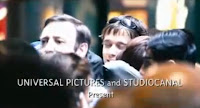The scene opens with a clip of the actor Anne Hathaway getting ready in the morning, this clip contains the names of two actresses in he film, 'Anne Hathaway' and 'Meryl Streep' because their names are the first to appear after the titles, we can easily guess that they are going to be the protagonists of the film. Also the text which their names are written in is red and gold, and in a calligraphy font, making it look feminine and delicate, connoting the female target audience and genre. The clip then cuts to a wide screened establishing shot of New York City. This connotes the setting of the film and that it is going to take place there.
In addition to the imagery, there is non-diegetic music being played. 'Suddenly i see' is a soundrack by KT Tunstall, the music is light hearted and ennergetic, which connotes a comical, girly theme. The lyrics of the song fit with the imagery, and describe a beautiful girl, and a woman aspiring to be just like her, this connotes ideas about what the film could be about, and what plots could be revealed.
 The opening scene is based upon the morning routine idea. It is set in various girls bedrooms and contains shots of them getting ready in the morning. The scene is created using parralell editing, creading the effect that the audience can see everything which is happening. From the start we can see that Anne Hathaway is the main character, becuase she gets the most screen time. However she is shown in contrast to the other girls. The toher girls in the scene are shown to be neat and glmorous. They also take their time in getting ready. Whilst on the other hand Anne Hathaway is shown to be scruffy and rushes herself. When the other girls are applying lipstick and eyeliner, Anne is shown to be quicly applying lipbalm then rushing out of the house. This creates a contrast in the opening scene and also makes it interesting as it starts to apply the personality of her character. This would engage the audience as they would want to follow her story. Also, the characteristics of the 'nerdy unpolular' girl are a stereotypical value of chick flick movies, where they end up falling in love, becoming sucsessfull and realising that they are beautiful, and people find this entertaining.
The opening scene is based upon the morning routine idea. It is set in various girls bedrooms and contains shots of them getting ready in the morning. The scene is created using parralell editing, creading the effect that the audience can see everything which is happening. From the start we can see that Anne Hathaway is the main character, becuase she gets the most screen time. However she is shown in contrast to the other girls. The toher girls in the scene are shown to be neat and glmorous. They also take their time in getting ready. Whilst on the other hand Anne Hathaway is shown to be scruffy and rushes herself. When the other girls are applying lipstick and eyeliner, Anne is shown to be quicly applying lipbalm then rushing out of the house. This creates a contrast in the opening scene and also makes it interesting as it starts to apply the personality of her character. This would engage the audience as they would want to follow her story. Also, the characteristics of the 'nerdy unpolular' girl are a stereotypical value of chick flick movies, where they end up falling in love, becoming sucsessfull and realising that they are beautiful, and people find this entertaining.The scene uses Levi Strauss' theory of binarry opposites to show the lifestyle and personallity of the different girls. For example we are shown to view Anne Hathaways character as unpopular and scruffy, whilkst we are shown to see the other girls as neat and glamorous. The opposites show conflict between eachother as we see majour differences with the parralell editing, as we see opposites which make the scene more interesting and comical, as well as connoting key convensions of a chick flick.



















